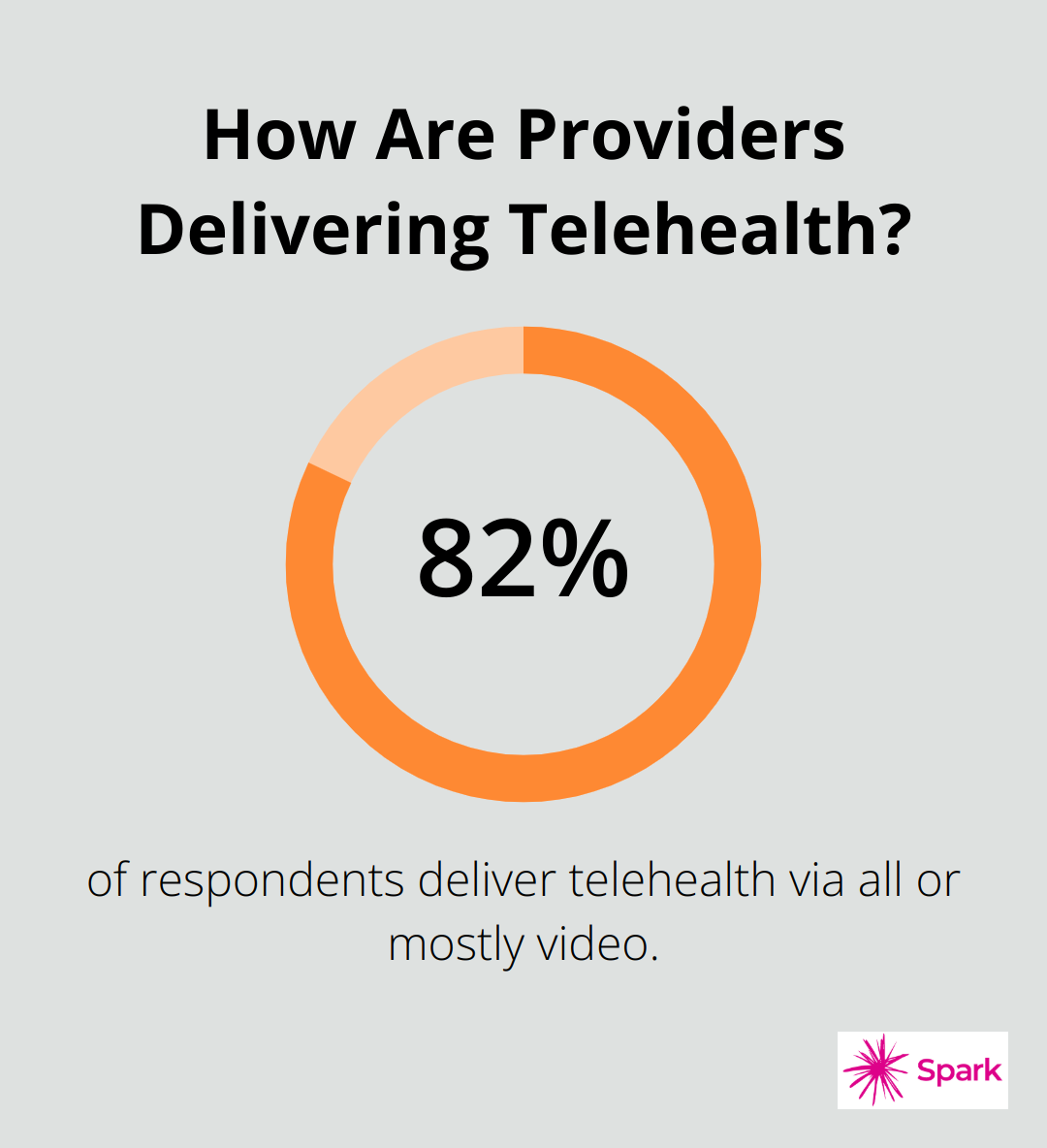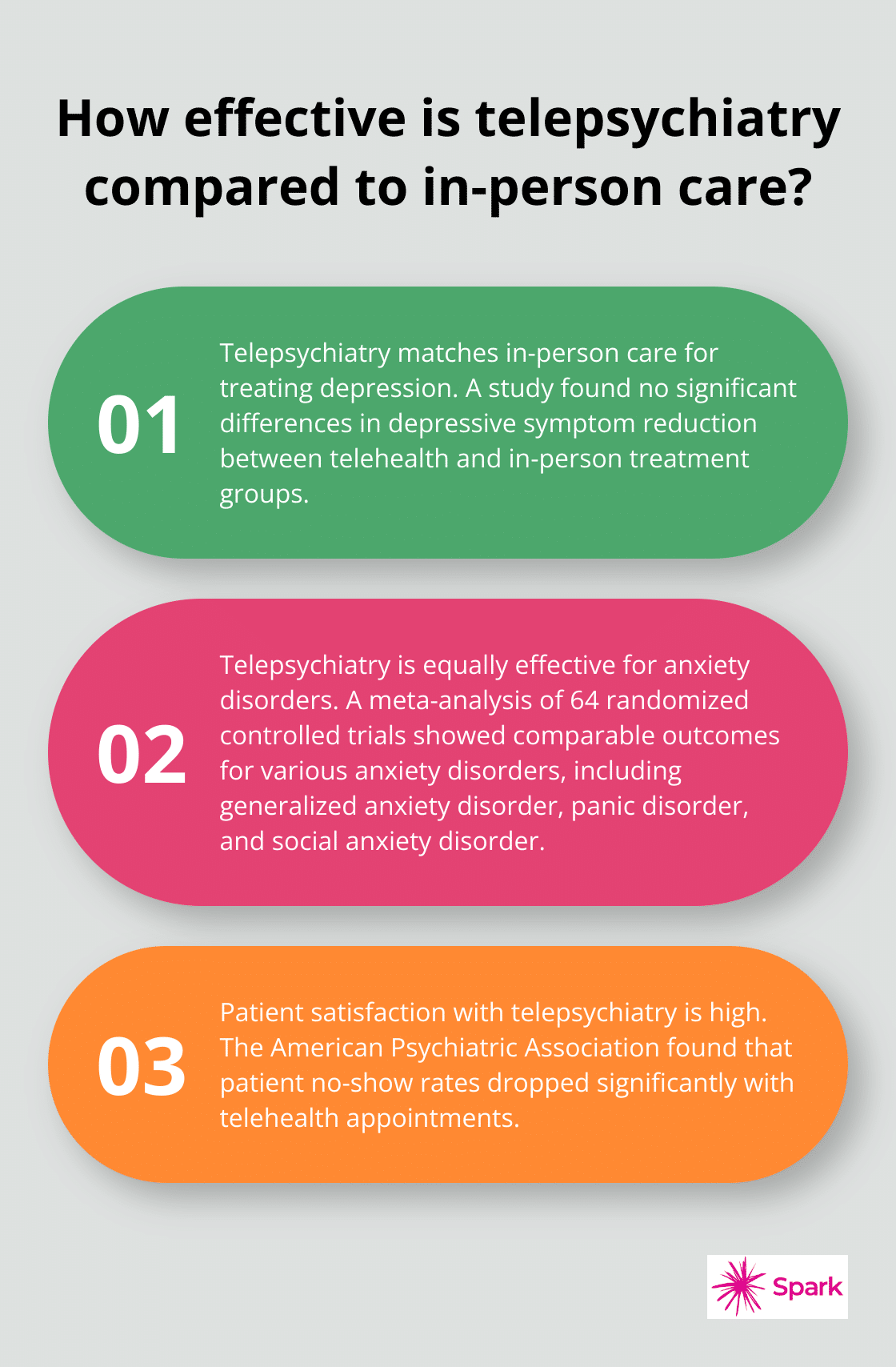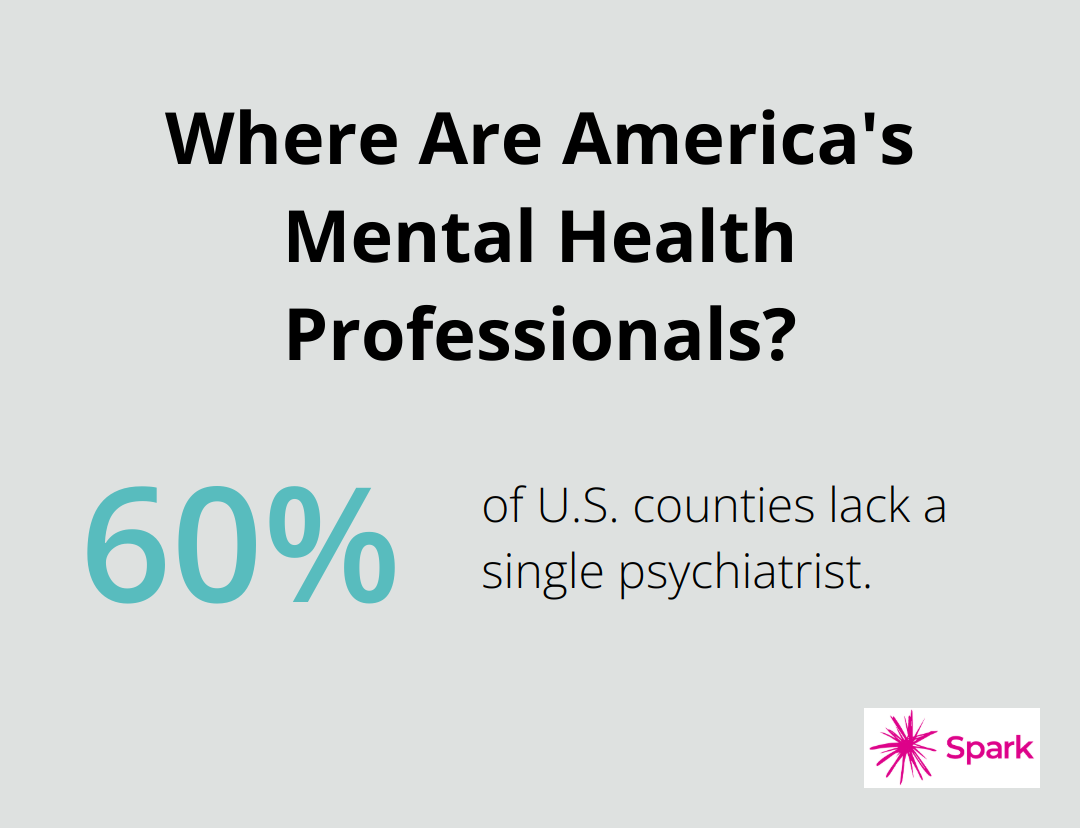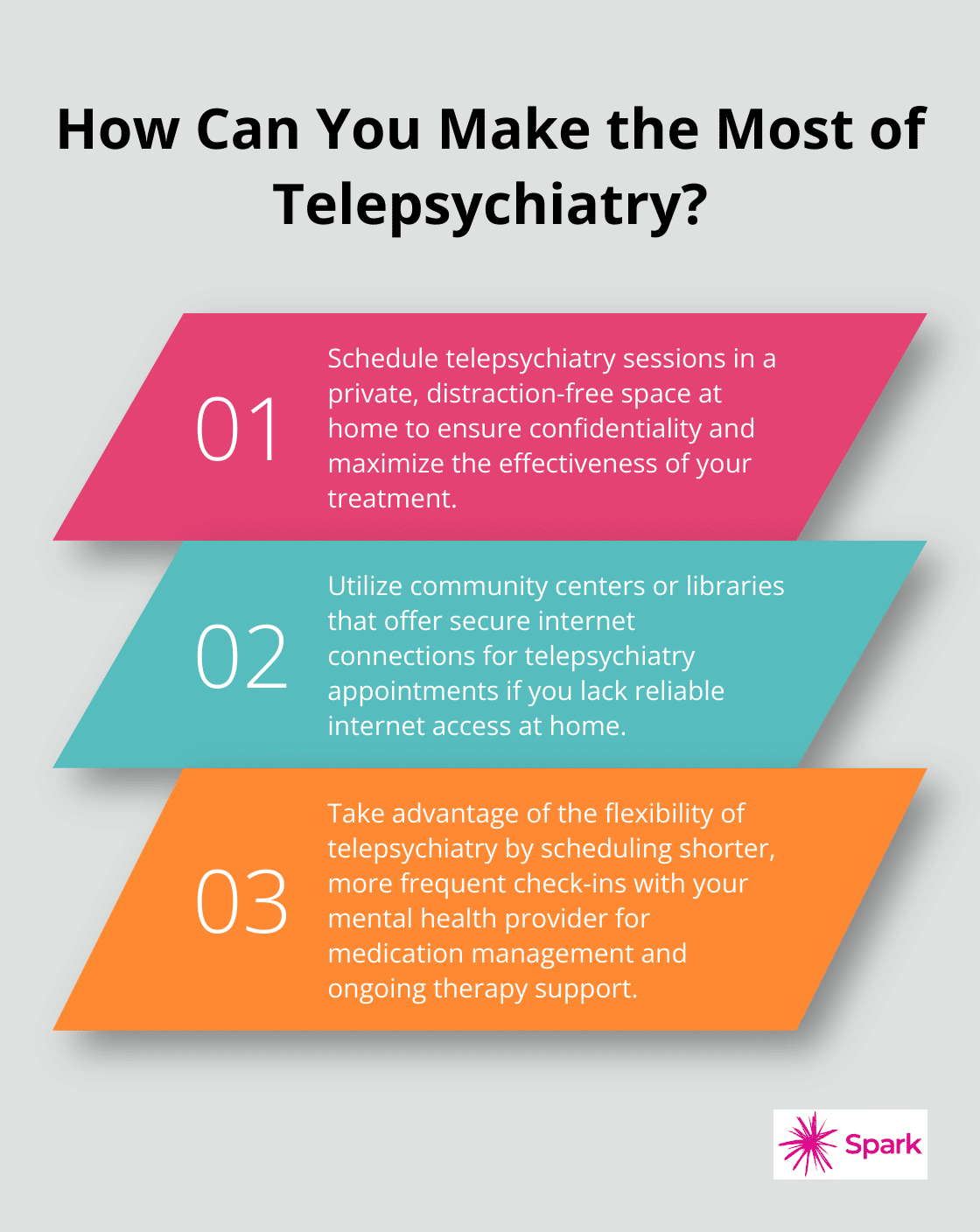The rise of telepsychiatry has sparked a debate in the mental health community: Is telepsychiatry effective compared to traditional in-person care?
At Spark Mental Health, we’ve seen firsthand how virtual psychiatric services have transformed access to mental health support.
This blog post explores the effectiveness of telepsychiatry, comparing it to in-person care and examining its impact on treatment outcomes, patient satisfaction, and healthcare accessibility.
How Do Telepsychiatry and In-Person Care Compare?
Definition and Practice
Telepsychiatry provides psychiatric care through digital platforms, typically via video conferencing. This approach allows patients to connect with mental health professionals from their homes or any private space with internet access. Traditional in-person psychiatric care involves face-to-face sessions in a clinical setting.
The Convenience Factor
One of the most significant differences between telepsychiatry and in-person care is convenience. Telepsychiatry eliminates the need for travel, which benefits patients in rural areas or those with mobility issues. A study found that 82% of respondents deliver telehealth via all or mostly video, indicating a high adoption rate of telepsychiatry services.
Accessibility and Reach
Telepsychiatry improves access to mental health care. According to the Health Resources and Services Administration, more than half (169 million) of the U.S. population lives in a Mental Health Professional Shortage Area as of December 2023. Telepsychiatry helps bridge this gap, extending care to underserved populations.
The Personal Touch
While telepsychiatry offers numerous benefits, some argue that it lacks the personal touch of in-person care. However, research published in the Journal of Clinical Psychiatry shows that the therapeutic alliance – a crucial factor in treatment success – is equally strong in telepsychiatry and in-person care.
Technology and Privacy Considerations
Telepsychiatry relies heavily on technology, which presents both advantages and challenges. It allows for flexible scheduling and reduces no-show rates, but it also requires a stable internet connection and basic tech literacy. Privacy is another important aspect. In-person sessions offer a controlled environment, while telepsychiatry requires patients to ensure their own private space. However, many telepsychiatry platforms employ end-to-end encryption to protect patient confidentiality.

As we move forward, it’s important to examine the effectiveness of telepsychiatry in more detail. Let’s explore the research findings on treatment outcomes, patient satisfaction rates, and cost-effectiveness comparisons in the next section.
Does Telepsychiatry Deliver Results?
Treatment Outcomes
Research consistently shows that telepsychiatry matches the effectiveness of in-person care for various mental health conditions. A study found no significant differences in depressive symptom reduction between telehealth and in-person treatment groups. This finding demonstrates telepsychiatry’s ability to treat one of the most common mental health disorders effectively.

For anxiety disorders, a meta-analysis in the Journal of Anxiety Disorders revealed that telepsychiatry interventions equaled face-to-face therapy in effectiveness. The study examined 64 randomized controlled trials and found comparable outcomes across various anxiety disorders (including generalized anxiety disorder, panic disorder, and social anxiety disorder).
Patient Satisfaction
Patient satisfaction indicates treatment effectiveness, and telepsychiatry excels in this area. A survey by the American Psychiatric Association found that patient no-show rates dropped significantly as telehealth became the primary way of keeping appointments.
Many patients appreciate the convenience and flexibility of online sessions. This aligns with broader industry findings that suggest telepsychiatry can improve treatment adherence and reduce no-show rates.
Cost-Effectiveness
Telepsychiatry not only matches the clinical effectiveness of in-person care but often proves more cost-effective. A study found that telepsychiatry increased mental health providers’ knowledge and enhanced their confidence in assisting their patients in rural areas. This can lead to improved care and potentially reduced costs.
Moreover, telepsychiatry can lead to fewer hospitalizations and emergency room visits. The Agency for Healthcare Research and Quality noted that one in eight emergency room visits involves mental health or substance use conditions. Timely access to care through telepsychiatry can help manage symptoms before they escalate, potentially reducing costly emergency interventions.
Breaking Down Barriers
Telepsychiatry extends beyond clinical outcomes and cost savings. It breaks down barriers to mental health care, especially for underserved populations. Patients in rural areas or those with mobility issues can now access quality mental health care from the comfort of their homes.
Technology and Privacy
While telepsychiatry offers numerous benefits, it relies heavily on technology. This dependence presents both advantages and challenges. It allows for flexible scheduling but requires a stable internet connection and basic tech literacy. Privacy remains a top priority, with many telepsychiatry platforms employing end-to-end encryption to protect patient confidentiality.
As we explore the effectiveness of telepsychiatry, it’s important to consider its advantages and limitations in more detail. The next section will examine how telepsychiatry increases accessibility and convenience while addressing potential challenges.
Telepsychiatry Advantages and Challenges
Breaking Down Geographic Barriers
Telepsychiatry has improved access to mental health care, especially in rural areas. The American Psychiatric Association reports that 60% of U.S. counties lack a single psychiatrist. Telepsychiatry bridges this gap, connecting patients in underserved areas with mental health professionals regardless of location.

A patient in rural Montana can now receive specialized treatment for obsessive-compulsive disorder from an expert in New York City, without extensive travel. This expanded access improves treatment outcomes and reduces the time between initial symptoms and professional intervention.
Flexibility and Convenience
The convenience of telepsychiatry is significant. Patients no longer need to take time off work, arrange childcare, or spend hours commuting for a 45-minute appointment. This flexibility has reduced missed appointments. A study in the Journal of Medical Internet Research found that no-show rates for telepsychiatry appointments were 3.5% lower than for in-person visits.
Telepsychiatry allows for more frequent, shorter check-ins, which can be important for medication management and ongoing therapy. Patients can easily schedule 15-minute follow-ups, leading to more consistent care and potentially better outcomes.
Technological Hurdles and Solutions
While telepsychiatry offers numerous benefits, it faces challenges. The digital divide remains a significant issue, with broadband access being correlated with improved health outcomes. This disparity can limit the reach of telepsychiatry services, particularly among older adults and low-income populations.
To address this, some mental health providers partner with community centers and libraries to offer secure, private spaces with reliable internet connections for telepsychiatry sessions. Additionally, companies develop mobile-friendly platforms that work well even on slower internet connections, ensuring that more patients can access care.
Privacy Concerns
Privacy concerns persist in telepsychiatry. While HIPAA-compliant platforms offer robust security measures, patients must ensure their own environment is private during sessions. Mental health professionals adapt by providing guidelines for creating a secure, distraction-free space at home for telepsychiatry appointments.
Expanding Access to Specialized Care
Telepsychiatry expands access to specialized mental health care. Patients with rare or complex conditions can now connect with experts who may be located far from their homes. This access to specialized care can lead to more accurate diagnoses and more effective treatment plans.
Final Thoughts
Telepsychiatry has proven to be an effective method of delivering mental health care. Research consistently shows that telepsychiatry matches the outcomes of traditional in-person treatment across various conditions. Patient satisfaction rates remain high, with many appreciating the convenience and flexibility of online sessions.

The future of telepsychiatry looks promising as technology continues to advance. We expect to see more innovative solutions that enhance the virtual care experience. The integration of artificial intelligence may lead to more personalized treatment plans and improved patient outcomes.
Spark Mental Health offers personalized, evidence-based telepsychiatry services for conditions such as anxiety, depression, ADHD, and PTSD. Our flexible online scheduling allows patients to access treatment from home using smartphones or other devices. We provide individualized care plans, medication management, and cognitive-behavioral therapy, while prioritizing accessibility and accepting various insurance plans (including Medicaid).






